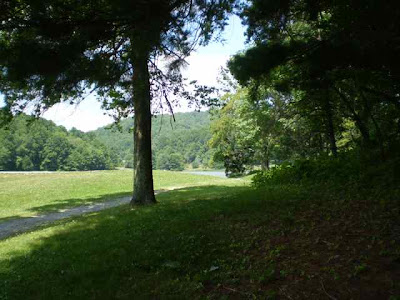Peaks
From my study window, I can see the Peaks of Otter over in Bedford County—Sharp Top and Flat Top. Sharp Top is obviously the one with the, well, sharp top.
No one is quite sure why the Peaks of Otter got the Otter part of their name. Here's the most common explanation:
There are three opinions on how the Peaks of Otter got their name. The name may come from the Cherokee Indian word, "ottari," which means "high places." The Peaks may have been named after the Otter River, which has its headwaters in the area. Finally, Scottish settlers may have named the Peaks after Ben Otter, a mountain in their homeland that resembles Sharp Top.
On Wednesday, my husband and I decided to take a mini-vacation to the Peaks (and to Tractor Supply in Bedford). Plus I wanted to visit the gift shop at the Peaks of Otter Lodge to see if they'd be interested in carrying Ferradiddledumday. They've carried my collection of short stories, The Girl Who Raced & Other Stories, for a few years. Ferradiddledumday would be perfect for the shop.
The gift shop manager wasn't in, so I left the information. Then we went outside to get a better looks at the Peaks. We walked past this old maple tree.
We could see Sharp Top just beyond the Lake.
See? The top really is sharp.
It was such a hot day, the shade on this little bridge felt good.
After we left the lodge, we stopped by the official visitor center, which also has a gift shop as well as many displays. Again, I left information about my book. Here's the view of Sharp Top, Route 43, and the Blue Ridge Parkway from the visitor center parking lot.
In the bathroom at the visitor center, I saw an interesting looking moth. I couldn't resist taking its picture. Anybody know what it is?
While we were at the Peaks, we visited the Polly Woods Ordinary, which was located near the picnic grounds.
The lower part of the front window was missing; a plastic bag covered the opening.
. . . and the latch on the front door.
The chinking between the logs didn't look authentic. I'd hoped that the old cabin would have been more faithfully restored. I also wondered if the upper story would have originally been made of sawn lumber. Was there a sawmill in the area in the early 1800s? There was no one around to answer my questions.
Something about the chimney didn't look quite right to John. It didn't look right to me either:
Mortar was used to fill the spaces between the rocks. Originally there would have been mud chinking. But the arrangement of the rocks didn't look historically accurate. In the old days, the rocks would have been fitted much more tightly, and they would have been stacked so there wouldn't be a vertical line between the courses. Had the old chimney been abandoned when the cabin was moved 150 feet to its present location?
Compare the chimney above to the chimney on my cabin, built by William Bernard in 1852 and restored by Willie Edwards in the 1960s. (This is actually a log cabin that was long ago covered in clapboards.)
See the difference? The rocks are laid more economically. Notice that the stones overlap so there aren't any vertical lines between the courses. Even though mortar is now between the stones instead of the original chinking, the chimney looks much more authentic. (The little window, by the way, was cut by William Bernard so he could sit by the fire and see his wife's grave on the hillside. He's now buried beside her.)
Below, the cabin on the old Smith Homeplace, originally built by a Mr. Street (who's buried in the yard) in the late 1700s and acquired by my great-great grandfather—Samuel Wood Smith (1813-1877), also has a chimney with stones laid similar to the Bernard/Smith one.
The section to the right is the original house, now covered with clapboards and painted. The section to the left was added later.
I wonder why the Polly Woods cabin's chimney wasn't restored more authentically? My interest is piqued.
Here's the view from the front of the Polly Wood's Ordinary:
Click HERE for info about the Parkway turning 75.
~



















3 Comments:
Great photo of you on the bridge.. I love that area. Hubby and I went last fall. The walk around the lake was really nice, although we had to share it with lots of other folks that day. Will probably go back this fall again. Were there any artists there? We saw 6 or 8 people there with their easels set up that day and painting the view of sharp top.
Di
Didn't see any artists. Not many people out. Even in the mountains, the temps were still high.
I expect the restoration was done as cheaply as possible. Authenticity is not always the goal.
Post a Comment
<< Home